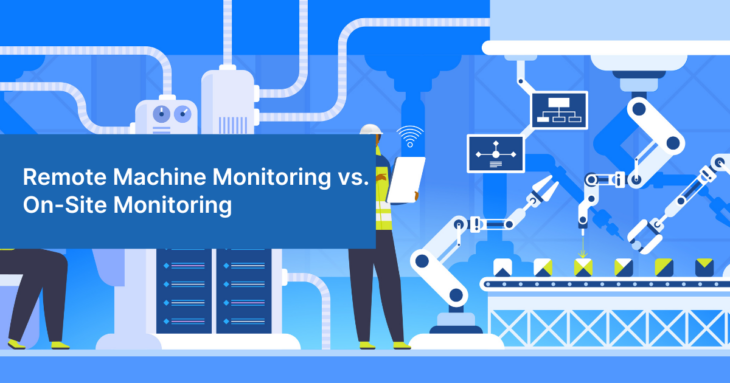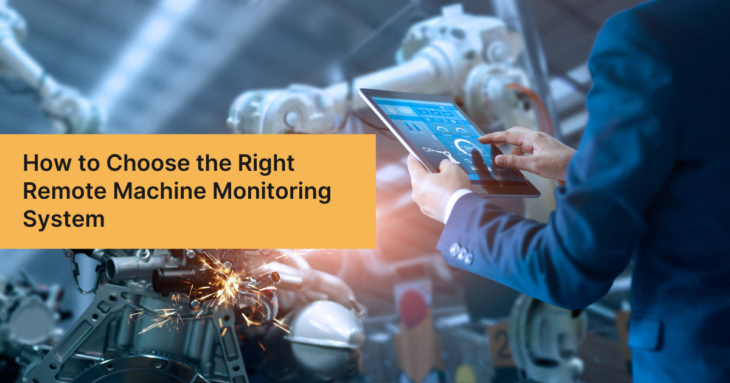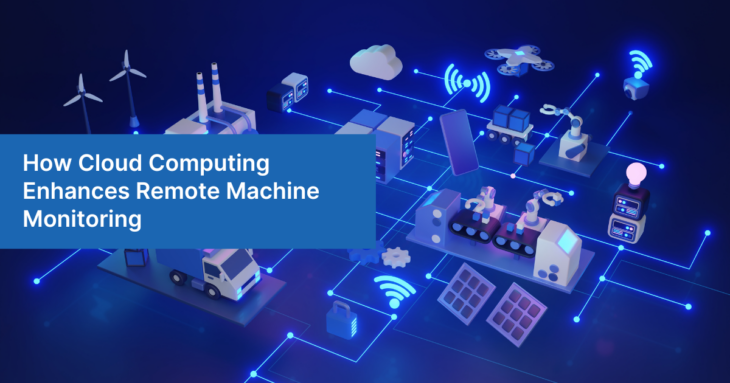Remote Machine Monitoring vs. On-Site Monitoring
Monitoring machinery in manufacturing is like having a pulse on the equipment. It tells you when the machines are running smoothly and helps catch issues before they spiral out of control. Traditionally, monitoring was done on-site with technicians physically present to check every detail. But as technology advances remote machine monitoring is becoming the next logical step as it offers real-time data and control from anywhere. In this article, we’ll take a closer look at remote machine monitoring vs. on-site monitoring and explore their benefits, challenges, and differences. On-Site Monitoring On-site monitoring is the traditional way of keeping an eye on machines in a manufacturing facility. It involves technicians and engineers being physically present to oversee operations. This manual approach allows them to monitor performance metrics, inspect components, and respond immediately to any issues. The technicians are always on-site watching machine parameters such as temperature, power consumption, spindle speed, tool wear, and other essential items specific to their process. One of the main advantages of on-site monitoring is the ability to access machine data instantly. Technicians on the ground can quickly spot and address abnormalities and minimize downtime. Because this method doesn’t rely on internet connectivity, it’s particularly useful in locations where network stability might be an issue. On-site monitoring requires a significant investment in human power and also needs skilled workers who are adept at monitoring machines and processes. Even in plants that employ some level of digitization to observe the process, on-site personnel are needed to monitor things. For companies with multiple manufacturing sites, scaling up on-site monitoring can also become costly. Remote Machine Monitoring Remote machine monitoring is made possible by using the Industrial Internet of Things (IIoT) and cloud-based platforms. With remote monitoring, manufacturers can collect real-time data from machines across multiple locations, analyze performance, and address issues without needing technicians on-site. One of the main benefits of remote monitoring is its scalability. Companies with multiple manufacturing sites can monitor all operations from a centralized dashboard and reduce the need for on-site staff. The data collected can be analyzed to identify patterns, predict maintenance needs, and prevent potential failures. In the long run, remote machine monitoring is useful for condition monitoring of machinery and equipment. Detailed performance data can be streamed and stored over time with sensors and IoT devices installed on machines. This data can be used to assess performance and predict loss in efficiency or equipment failure well in advance. While there are downsides to remote machine monitoring in the form of network and cybersecurity challenges, it is better in every parameter compared to on-site monitoring. Remote Machine Monitoring Vs. On-site Monitoring (H2) Now let’s look at some of the key remote machine monitoring vs. on-site monitoring differences: Difference Parameter Remote Machine Monitoring On-Site Monitoring Cost Savings Remote monitoring offers greater cost efficiency compared to on-site monitoring. On-site monitoring requires continuous investment in personnel, training equipment, and operations. It can add up in terms of cost especially in large or multi-site operations. Scalability Scalability with remote monitoring is a major benefit as it allows manufacturers to oversee multiple sites from a centralized location. The need for physical presence and skilled technicians limits on-site monitoring. Since an extensive training period is involved, scaling is slower compared to remote monitoring. Data Collection and Analytics Remote monitoring systems are designed to collect vast amounts of data in real-time. The data is instantly updated to secure servers and is available for analytics almost instantaneously. On-site monitoring can gather high-quality data. However, uploading manual data to the MES or ERP systems takes time, which makes instantaneous analytics impossible. Maintenance and Downtime Management By using predictive analytics, remote systems can identify potential issues before they lead to machine failure. Maintenance than then be scheduled appropriately. On-site monitoring is often reactive and addresses issues only after they’ve occurred. Security and Compliance Remote monitoring systems rely on internet networks making them vulnerable to cybersecurity threats. However, remote service providers have robust security features for data transfer and storage. On-site monitoring faces physical security risks, data breaches from human error, and sabotage. Compliance with industry standards also has to be part of mandatory training for the personnel. Decision Making Remote monitoring makes instantaneous, data-driven decisions a common thing with manufacturers. Collecting real-time data from machines provides a complete overview of operations that can be analyzed to identify trends and optimize performance. On-site monitoring also supports data-driven decision-making. However, there is a significant lag from when the data is collected to when it is uploaded to the system for analytics. The lack of real-time insight makes it hard to detect immediate trends and early warning signs. Competitive Advantage for Manufacturers With the world already in Industry 4.0, manufacturers adopting remote monitoring have a competitive edge over others. Moreover, they are able to offer better maintenance to clients backed by robust data. Although on-site monitoring is effective in smaller localized operations, it may not offer the same level of flexibility and scalability. Manufacturers relying solely on on-site monitoring might find it more challenging to compete globally. To Wrap It Up While both remote and on-site machine monitoring play their roles in manufacturing, the future is remote. We have seen the differences in remote machine monitoring vs. on-site monitoring in terms of cost, security and data-backed decision-making, and there’s a clear winner. Manufacturers need to incorporate remote machine monitoring to stay competitive in an ever-growing digital production ecosystem. If you wish to learn more about how you can upgrade to remote machine monitoring, get in touch with our team and request a demo!
Read MoreHow to Choose the Right Remote Machine Monitoring System?
If you’re assessing the feasibility of a machine monitoring system for your manufacturing unit, then you’re headed in the right direction. Remote monitoring is becoming a staple in manufacturing as the current shifts towards Industry 4.0. According to a McKinsey survey, digital upgrade of existing systems is now a top priority among machinery companies. The benefits it unlocks set them apart from the rest and open up business opportunities that were previously unavailable. So, how do you go about choosing the right remote machine monitoring system? In this article, we examine 8 key aspects and one case study on how it’s done right. Factors to Consider When Choosing a Remote Machine Monitoring System It’s a crucial decision requiring you to evaluate the following factors: 1. Assess the Monitoring Needs of Your Unit Start by pinpointing the specific metrics crucial for your operations that are ready for a digital transformation. Are you trying to track the resources through the plant or measure the temperature of a cast product through the conveyer system? It could be different things, from fluid temperature to hydraulic pressure in the pumps. Assess your existing setup and come up with gaps where the implementation of remote monitoring can be most useful. 2. Consider System Compatibility With Existing Equipment One of the most important aspects of choosing the right remote machine monitoring system is compatibility with your equipment. Even the most advanced solution in the market isn’t good enough if it doesn’t work with your equipment without major modifications. Compatibility reduces installation costs and avoids disrupting your operations. The monitoring solutions should support your equipment’s protocols and communication standards. Also, consider future upgrades and select a system adaptable to emerging systems so you’re not forced into costly replacements in the long run. 3. Look for Scalability With Your Business Your business is bound to grow and expand, and hence, any remote monitoring system you choose should be able to scale without offering resistance. Modular designs are particularly beneficial as they let you add new features or devices without reconfiguring the entire system. The same goes for upgrades, as any new IoT device you introduce should fit perfectly with the system. Consider how the system handles increased data volumes and additional sensors. The monitoring system should also be able to offer services customizable to any unique needs that you have. 4. Evaluate Data Security Features Data security is critical as the system exchanges information from devices to the monitoring platform. The system should have robust encryption to protect data both during transmission and in storage. The system should also include advanced authentication methods, such as multi-factor authentication, to prevent unauthorized access. The vendor should also provide regular security updates and patches to safeguard against vulnerabilities. 5. Check for User Friendliness of Solution A surprising vulnerability to most upgrades comes from those who use completely new systems. Workers in the manufacturing sector are sometimes reluctant to adapt to digital technology as they are more comfortable with manual methods. Therefore, the monitoring solution must be user-friendly and feel like using any other intuitive application. Evaluate whether the system offers customizable dashboards and simple controls for accessing critical data. Also, consider the availability of training resources and customer support to help with onboarding and troubleshooting. 6. Make Cost Assessments Cost is a significant factor in how most manufacturers choose a remote machine monitoring system. Start by comparing the initial investment required for each option, including hardware, software, and installation fees. Also, you must factor in ongoing costs such as maintenance, subscription fees, and additional updates or support charges. A good metric to assess vendors is transparent pricing with no hidden costs. Start with a cost and benefit analysis to weigh the expenses against the potential gains regarding efficiency, downtime, and productivity. 7. Review Vendor Reputation Most vendors out there advertise the best of their services and make claims about how good their platforms and services are. It’s essential to look at the customer testimonials and reviews to understand whether their offerings are good. Look for feedback on the vendor’s customer service, support responsiveness, and overall satisfaction. Check if the vendor has a track record of delivering quality products and solutions in the case studies of real applications. Finally, consider their experience in the industry and any awards or certifications they’ve received. 8. Test System With A Trial Run Once you’ve zeroed in on your vendor or vendors, start with a test run to observe their performance. Many vendors offer demo versions or trial periods, allowing you to evaluate the system’s performance in your environment. Use the test runs to assess how well the system integrates with your existing equipment, its ease of use, and its ability to deliver data effectively. Pay particular attention to any issues that arise and how quickly support responds, as this will be one of the weakest links going forward. Case Study: Enhanced Productivity Performance and Machine Utilization With MachineCONNECT The client is a machine builder in the manufacturing sector. As often happens in this industry, the client faced challenges with incomplete and inaccurate manual data on production parts, setup times, and manual delays. They also struggled to gauge performance against productivity targets effectively. Solution: Implementing machineCONNECT transformed their operations. The remote machine monitoring solution automated data collection on parts produced and cycle times. It also monitored setup times and analyzed machine performance to pinpoint productivity losses and unused capacity. Outcome: By identifying and resolving bottlenecks, the client significantly improved productivity and gained higher machine utilization. The effect reduced the need for additional capital expenditures and saved money. The detailed insights into productivity losses also enabled targeted performance enhancements. Conclusion Selecting the right remote machine monitoring system can make all the difference in optimizing manufacturing processes. By following the steps discussed in the article, you have a general framework for how to analyze and choose the right remote machine monitoring system. On that note, machineCONNECT’s remote monitoring has a proven track record in boosting manufacturing productivity and
Read MoreHow Cloud Computing Enhances Remote Machine Monitoring
Cloud computing has been a significant leap in modern technology as processing and storage have moved from fixed personal hardware to the cloud. It lets businesses store and process data without needing to build out massive physical infrastructure, making it easier and more cost-effective. Regarding remote machine monitoring, cloud computing takes things up a notch. It enables IoT platforms and intelligent monitoring systems to access the cloud, which can be used as a subscription mode. The technology is a leap in how manufacturers manage and access data, allowing them to analyze machine performance in real time from anywhere. This means manufacturers can make smarter decisions and keep operations running smoothly without being bogged down by traditional methods. In this article, we look closely into cloud computing remote machine monitoring. How Cloud Computing Works Cloud computing is a technology that allows businesses to access and use computing resources like storage and processing power over the internet rather than relying on local servers or hardware. This means manufacturers using remote monitoring systems don’t need to invest in computer hardware for their process needs. A key characteristic feature of cloud computing is the availability of on-demand resources. It’s basically computing power that they can use only when needed. Therefore the system gives vast resources for scalability, allowing manufacturers to increase the size of operations based on demand. The cost benefits of cloud computing are also massive since enormous computer power can be accessed without having to spend a fortune on high-performance hardware. How Cloud Computing Enhances Remote Monitoring Remote machine monitoring utilizes IoT devices to gather various forms of data from production plants related to the processes, such as temperature, pressure, flow, weight, speed, etc. All of this data can be stored on-site using local servers or physical storage. Remote machine monitoring service providers these days choose the cloud to overcome the limitations of on-site operations. Here are some of how cloud computing enhances remote monitoring: 1. Centralized Data Management Cloud computing provides secure data storage solutions by allowing manufacturers to store vast amounts of data on cloud servers, which can be scaled based on need. This eliminates physical storage limitations and reduces the risk of data loss through advanced security measures like encryption and backups. Centralized data access is another major advantage of cloud computing. It enables remote monitoring solutions to store and retrieve information from any location with an internet connection. The accessibility gives crucial data in real-time and supports better decision-making through immediate access to data and analytics. 2. Enhanced Data Analysis Analysis of acquired data from the IoT network for actionable insights is one of the core functions of remote monitoring systems. Cloud computing takes this data analysis to the next level by enabling real-time processing. This means operators can monitor and analyze machine data as it’s collected, giving them up-to-the-minute insights. No more waiting for reports or sifting through outdated information. What’s more, cloud-based tools and AI enhance this process with advanced analytics that can spot trends and predict issues before they become problems. Cloud computing’s vast processing resources can crunch large datasets quickly. It provides valuable performance insights and helps operators make informed decisions. 3. Scalability and Flexibility Cloud platforms do a great job in resource allocation, letting manufacturers scale resources up or down based on demand. For example, if the resource monitoring system needs extra computing power during peak production times, the cloud can quickly provide it. The high flexibility in resources ensures that businesses only pay for what they use. Additionally, cloud computing supports the integration of new technologies like AI or advanced analytics tools. It also allows for easy expansion of monitoring capabilities when the size of the operation is increased geographically. With all this adaptability, manufacturers can continuously scale their systems as per demand without major upgrades. 4. Improved Security and Compliance For manufacturers using remote machine monitoring on a large scale, cloud computing offers advanced security features that protect important data. Cloud services always include robust encryption, securing data in transit and storage. They also have comprehensive access controls to ensure only authorized personnel can access specific information. It’s also important to mention that cloud providers are committed to adhering to industry standards and regulatory requirements, ensuring compliance with the law. Therefore, manufacturers who choose cloud-based remote monitoring platforms benefit from top-notch security. 5. Cost Effectiveness One of the biggest advantages of cloud computing comes in terms of cost through its pay-as-you-use model. Instead of investing in expensive hardware and paying for unused resources, businesses only pay for the resources they use. This flexibility helps manage expenses and spend money only when an actual demand exists. Cloud solutions also reduce maintenance costs by eliminating the need for infrastructure on-premises, such as servers and storage devices. There’s no need for physical servers or the associated maintenance, such as repairs or upgrades. This lowers overall operational costs and frees up resources for other critical business areas. For manufacturers using cloud computing remote machine monitoring, the cost can work out most economically, especially when they have an operation spread across cities or the globe. Closing Thoughts Cloud-based remote monitoring platforms are a major leap forward for manufacturers as they offer plenty of product efficiency and cost-cutting benefits. By utilizing real-time data processing, advanced analytics, and scalable resources, the platforms provide manufacturers with actionable insights and the flexibility to adapt to changing process needs. Improved security and compliance ensure that sensitive data is protected, while the cost-efficiency of pay-as-you-use models and reduced maintenance expenses make cloud solutions an attractive choice. Are you curious about how cloud-based solutions can give a leg up to your manufacturing operations? Discover the power of MachineCONNECT today. Our advanced remote monitoring platform leverages the latest in cloud technology to provide you with real-time insights, enhanced security, and cost-effective remote machine monitoring. Request a Demo Today!
Read More

